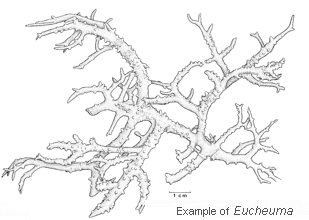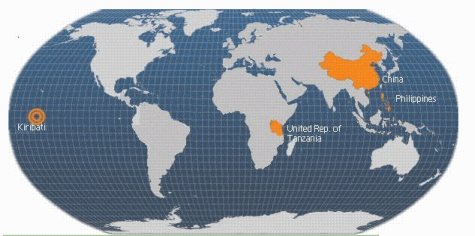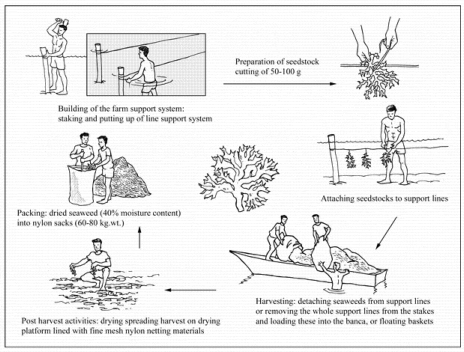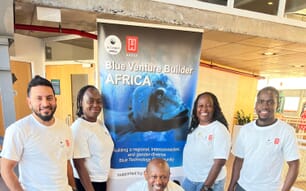Identity
Eucheuma spp , [Solieriaceae]
FAO Names: En - Eucheuma seaweeds nei, Fr - , Es -
View SIDP Species fact sheet

Biological features
Habit variable, thallus sometimes tall and loosely branched with few blunt or pointed determinate branchlets, sometimes densely branched with many coarse spinose branchlets. Branchlets irregularly arranged on main indeterminate branches without forming whorls. Cross-section of branch shows medulla consisting of large rounded cells interspersed with small relatively thick walled cells.
Profile
Historical background
In the 1960s an American seaweed processing company transferred its procurement of raw materials for the production of carrageenan from Indonesia to the Philippines. During its initial operations the company sourced its supply of raw materials by gathering/collecting the seaweeds from the reefs of islands in the Central Visayas. The unabated gathering of natural stocks resulted to depletion of the stocks towards the later part of the decade. The short supply of dried seaweeds for processing triggered research and development work on the culture of these species, the survey and assessment of coastal areas with potential for seaweed farming, and an inventory of the local varieties of these species for comparative growth studies and assessment of the quality of their colloidal products.
The surveys for potential farming areas centered mainly on Western Mindanao and Central Visayas in the Philippines. Experimental culture was initiated in several sites which included Calatagan, Batangas, Ilin Island in Mindoro and in Danajon Reef, Northern Bohol. In early 1970, these efforts were extended to Sacol Island in the province of Zamboanga and in Tapaan Island lagoon in Siasi province of Sulu. The first commercial farm for Eucheuma/Kappaphycus was established in Tapaan Island in 1972. Meanwhile, test planting in Danajon Reef was also started resulting to the establishment of commercial farms by the Cebu-based seaweed processing companies in the mid 1970s where the two species were utilised as seedstocks. Due to increasing demand for the dried seaweeds in both local and international markets the farming of these seaweeds had expanded to Western Mindanao, Northern, Eastern and Southern Mindanao including the province of Palawan, as well as to Eastern Malaysia (Sabah and Sarawak) and Indonesia.
Main producer countries
The FAO statistics for these four groups of seaweeds (Kappaphycus alvarezii, Eucheuma cottonii, Eucheuma denticulatum and Eucheuma spp.) are combined within the map shown below. However, this does not present the whole story, since Indonesia, Malaysia, Solomon Islands and Fiji Islands are also producers but do not report them separately (see section on Production statistics below).

Habitat and biology
These seaweeds are the most common and fast growing species in the Philippines and are found from just below the low tide mark to the upper subtidal zone of the reef, growing usually on sandy-corally to rocky substrata where water movement is slow to moderate. They grow by means of an apical meristem consisting of a group of actively dividing cells at the tip of the branches. They exhibit a triphasic life cycle, consisting of the gametophyte (n) (dioecious), carposporophyte (2n) and the sporophyte (2n).
The fertilisation of the egg in the carpogonium of the female gametophyte by the spermatium results in the production of the zygote, which in turn develops into the microscopic carposporophyte within the fertile structure called cystocarp in the female gametophyte.
The carpospores (2n) produced by the carposporophytes develop into the tetrasporophytes. Meiosis takes place in the tetrasporangia, resulting to the production of tetraspores (n) which in turn develop into the gametophytes.
The gametophyte and the sporophyte are the large phases in the life cycle of this seaweed. The latter, however is the more robust of the two (2n). These seaweeds are characterised by their high vegetative regenerative capacities; these characteristics are used by farmers to their advantage.
Production

Production systems
Seed supply
Twelve varieties of K. alvarezii have been characterised based on their morphology, DNA fingerprints and growth performance during the different cropping seasons. The information derived from these studies is important and very relevant to the cropping management in farms where the farmers use several varieties as seedstocks. The present seedstocks are endemic in the Philippines.
Supplies of seedstock are sourced from the wild and multiplied in a nursery plot. The original seedstock is washed clean of dirt and other contaminants and transported as quickly as possible to the nursery site in Styrofoam boxes with air holes in the top, without exposing it to sun and wind. The nursery-reared cuttings become the seedstock for the first grow-out. Subsequent supplies of seedstock are obtained from the first cropping, and so on.
Ongrowing techniques
The most important aspect in developing a potentially productive seaweed farm is site selection. The site must be assessed to conform to the following criteria:
- Moderate water current and wave action to maintain high diffusion pressure which enhances the absorption of nutrients by the seaweed.
- Adequate but not excessive light; irradiance levels of 500-900 µEm-2S-1 are optimum for both photosynthesis and pigment synthesis.
- Sufficient water depth; in shallow areas the seedstocks must not be exposed during low tides. The development of the floating farm support system has made farming in deep areas possible.
- When farming shallow areas the substratum must be dark, consisting of coarse sand to rocky-corally materials; substrata consisting of white fine sand must be avoided.
- Minimal presence of grazers, microorganisms, silt epiphytes and flotsam.
- Optimum temperature range 27-30 ºC.
- Salinity level of 30-35 per cent; brackish water areas should be avoided.
The total grow-out period varies from 2-3 months after planting; thus, four cropping cycles are feasible within a year.
Seedstocks are prepared by tying 50-100 g pieces of cuttings with soft plastic tying materials. The cuttings are tied at 20-25 cm intervals to the monolines in both the bottom monoline and the floating methods.
Two main farming systems are presently used by farmers. These are the fixed off-bottom monoline and the floating methods. In each case farm maintenance consists primarily of weeding out epiphytes associated with the crop, cleaning the seaweed of silt and dirt, harvesting the poorly growing seedstocks and replacing them with fast growing ones, removing other species of seaweeds that grow in close association with the Eucheuma, replacing lost plants, repairing the farm support system and removing benthic grazers. Epiphytes and flotsam compete with seaweed for nutrients and energy from sunlight resulting in slow growth of the crop.
The Fixed off-Bottom Monoline Method
Construction of the farm support system starts with knocking holes in the substratum using a pointed iron bar and heavy bull hammer. Pointed wooden stakes are firmly driven into the holes in the substratum using a ball hammer. The stakes are arranged in rows at 1 m intervals, with the distance between rows being 10 m. A loop is made at one end of the monofilament line and is attached to a stake. The line is then stretched tightly and the other end tied to a stake in the next row. The distance of the lines from the ground is adjusted to the depth of the water during low tides so that the plants are not exposed to air and sun. The lines are generally positioned parallel to the direction of the current or waves. An additional support stake may be placed midway between the original rows of stakes to prevent the lines from sagging.
Floating Methods
These methods are used in deeper areas as well as in shallow areas that are characterised by weak water movement or where the bottom topography is irregular.
Monolines
In the raft method, the monolines are attached to a wooden or bamboo frame, the size of which varies depending on the available frame materials. The monolines are attached to the frame parallel to the length of the frame at 20-30 cm intervals. A 4 x 5 m raft unit may be planted with 350-400 cuttings. The units are anchored to the substrate from their corners, using nylon ropes. Floatation materials are attached to the corner of the rafts to increase their buoyancy.
Floating longlines
The floating longlines have two major variations – single and multiple. In the single variant, 100 m nylon ropes (3-4 mm diameter) are used as main support lines, both ends of which are anchored to the substratum. The level of the lines in relation to the surface of the water column is determined by adjusting the length of the line of the floatation device. Single floating lines are distanced some 5-8 meters apart to avoid them from becoming entangled.
Multiple long line units consist of 4-5 nylon lines (3-4 mm diameter), each of 20 m length or more. The ends of the lines are attached at 30 cm intervals to the main spacing supports, which consist of 3 to 4 cm thick hardwood. Depending on the length of the lines, one or more wood spacers are attached to the middle of the unit. The corner ends of the units are directly anchored to the substratum or are attached (tied) to the main support anchor line (5-6 mm nylon rope) in series at 2 m intervals.
Harvesting techniques
Seaweed that is grown for less than 10 weeks is immature and contains little carrageenan. For the best quality product, the crop should be harvested 10-12 weeks after planting to allow the crop to mature.
Handling and processing
Harvesting simply consists of detaching the stocks from the support line, placing them in a bangka boat (a vessel that looks like a catamaran) and transporting them to the drying area.
Traditionally the harvested seaweed is cleaned, sorted, and freed from dirt and other seaweeds, before being sun-dried on clean drying platforms (usually made of bamboo slats). This method had been slightly modified recently to minimise the loss of materials and facilitate improved drying. The platform is first lined with fine-mesh braided nylon net and the harvest is spread on top of it. The plants are regularly turned over to ensure complete sun-drying. The drying crop must be protected from rain: the crop is piled into a heap by pulling the lining net to one part of the platform which is then covered by a waterproof sheet. During hot, sunny weather, the harvest may be dried in two or three days. The final moisture content of the crop should not be more than be 40 per cent. The dried material is tightly packed in plastic sacks and stored in dry areas before shipment to buying centres.
There are two commercial carrageenan products - refined or 'traditionally extracted carrageenan' and ‘semi-refined carrageenan’ (SRC) or 'Philippines Natural Grade Carrageenan' (PNG). Refined carrageenan is processed by boiling the seaweed in alkali for several hours under oxygenated conditions. The dissolved carrageenan is leached into a solution and subjected to viscosity control, pumped and filtered, then coagulated in alcohol. The coagulate is dried and powdered. On the other hand, PNG carrageenan is processed by soaking the freshly harvested or dried seaweeds in alkali at a moderate temperature. 90 ºC is used for Kappaphycus (‘kappa carrageenan’) and 60 ºC for Eucheuma (‘iota carrageenan’). This process does not involve the dissolution and leaching of carrageenan into solution. The carrageenan remains intact and protected by the inert cellulose matrix of the cell walls.
Production costs
Production costs are dependent on three factors, namely fixed assets, operating expenses and depreciation costs. The operating cost for a typical 0.25 ha farm, for example, represents 75 per cent of the production cost, mainly the cost of seedlings, labour and some miscellaneous expenses. Labour represents ~72 per cent of the production cost, while fixed assets (supplies and materials needed for the construction of the farm support system) represent 23 per cent and depreciation a maximum of 2.0 per cent Return on investment depends on the productivity of the farms and would vary depending on the growth rates of the plants. Acceptable daily growth rates of 'seeds' should not be lower than 3.0 to 4.0 per cent. If this level of over 2.5 to 3.0 months the ROI will vary from 40-45 per cent.
Diseases and control measures
Three biological factors that cause tremendous loss of biomass in farms are 'ice-ice disease', epiphytism and grazing (thought the latter is not a ‘disease’).
| DISEASE | AGENT | TYPE | SYNDROME | MEASURES |
|---|---|---|---|---|
| Grazing | Herbivores | Fish & invertebrates | Loss of biomass; occurs year-round | Use floating method in deeper areas |
| Epiphytes | Benthic algae | Filamentous | Epiphytic blooms; occurs in summer | Submerge 1 m below water surface in areas with moderate current |
| ‘Ice-ice’ | Microorganisms | Bacteria & fungi | Slow growth rate; pale thalli; loss of shiny branch surfaces; presence of epiphytes & flotsam; occurs in calm weather & summer months | Transfer to areas where water is cool & current movement good |
Suppliers of Pathology Expertise
Expertise in pathology can be obtained from the following sources:
- Microbiology Department, National Science Research Institute, College of Science, University of the Philippines, Quezon City, Philippines 1101.
- Microbiology Section, Southeast Asian Fisheries Development Council, Tigbauan, Iloilo, Philippines.
- Marine Science Institute, College of Science University of the Philippines, Quezon City, Philippines 1101.
Statistics

The FAO statistics for these four groups of seaweeds are combined within the chart shown above. The main producers are the Philippines and, since 2003, China. By 2005, nearly 92 per cent of global production came from the Philippines and 7 per cent from China. However, this does not present the whole picture, since Indonesia and (Eastern) Malaysia are also significant producers of these species but their output is not specifically reported to FAO, being ‘hidden’ within the more general statistical categories ‘red seaweeds’ and ‘aquatic plants nei’ respectively. Tanzania and Kiribati are the leading minor producers of this group of seaweeds.
Market and trade
The local market for dried seaweed in the Philippines consists of farmers selling their produce through the main channels, which are local traders, farmers' cooperatives and non-governmental organisations. The dried produce goes to large buying stations in the area commissioned by big processing companies. Independent traders may also sell their stocks directly to local exporters who sell them on to international processors.
Two general forms of products are exported to the international market as well as dried seaweeds. These are (a) semi-refined carrageenan (SRC) or natural grade carrageenan (PNG) and (b) refined carrageenan or ‘traditionally extracted carrageenan’. Dried seaweeds for export must conform to the following requirements: moisture <40 per cent; contaminants: <1.0 per cent percent.
The processing of PNG utilises the non-extractive method which leaves more than 2.0 per cent acid insoluble matter (AIM) in the product with cloudier gel compared to refined carrageenan. The method of processing of refined carrageenan utilises the extractive method. It is possible to extract pure carrageenan after alcohol precipitation. A large portion of dried produce in the Philippines is processed in Cebu and in Zamboanga provinces.
According to the Seaweed Industry Association of the Philippines, three types of product are exported by the 22 industry players, namely, dried seaweed, semi-refined carrageenan and refined carrageenan. Eighteen of the exporters sold raw materials at an average price of USD 0.55/kg in 2004, while thirteen of them exported semi-refined carrageenan at an average of USD 3.95/kg and only five of them processed and exported refined carrageenan at an average price of USD 8.68/kg.
The export market for carrageenan from the Philippines consists of Europe, North America, Asia, South America, New Zealand and Australia, in that order of importance.
The seaweed industry in the Philippines imports minor amount of seaweeds from US, Chile, Indonesia, and Singapore. The latter two countries supply the Philippines with raw material for iota and kappa carrageenan from Eucheuma/Kappaphycus, while the US and Chile supply raw material for the manufacture of lambda carrageenan, mostly from the genus Iridaea.
Status and trends
Seaweed farming is currently the largest and most productive form of livelihood among the coastal population of the Philippines. Data/information from the Seaweed Industry Association of The Philippines for 2004 indicated that more than 116 000 families consisting of more than 1 million individuals were farming more than 58 000 ha of seaweed. In 2000-2004, the average annual production of dried seaweeds in the Philippines was nearly 125 000 tonnes, with a value averaging about USD 139 million. World demand for seaweeds and seaweeds products is projected to remain at 10 per cent annual growth rate. In order to supply the high demand for dried seaweeds as raw materials for carrageenan production the industry is expanding the farming of seaweeds to new sites/areas. The development of the floating methods of farming presently applied to deeper areas has contributed significantly to the increase in farm areas and production.
During the past decade the industry noticeable declines in the productivity of farms in the traditional crowded farming areas, caused by the seasonal occurrence of farm malaise locally known as 'ice-ice disease' and 'buhok-buhok' (epiphytism) which wrought havoc. Field observations have shown that the occurrence of this malaise appeared to be ecologically induced by drastic changes in environmental factors and the different growth responses of several varieties of seedstocks. Research is presently being implemented to resolve these ecological problems. At present the carrageenan producing countries are farming two types of carrageenan-producing species of seaweed, the bulk of which comprise kappa carrageenan bearing seaweeds.
The seaweed Industry of the Philippines is projected to remain the main producer and supplier of raw material in the world market due to the strength of the industry and its opportunities, notwithstanding its weaknesses and threats.
In order to strengthen the future of the industry, two important concerns will have to be addressed: enhancing production capacity for dried seaweeds and encouraging more investment in the industry. The enhancement of production capacity has begun through improvements in farming and harvesting, post-harvest technology to improve quality, the expansion of farming to new sites that conform to site selection criteria. The problem with seedstock supply has been resolved by establishing farms designed mainly for the production of 'seedlings' for other farmers. The comparative growth responses of the 12 kappa -producing varieties have already been documented and information on cropping management has been recommended. The apparent decrease in the vigour of the seedstocks, due to their repeated use through the years, is being studied. Hybridisation through somatic fusion is hampered by the lack of the enzyme carrageenase which can dissolve the cell walls to isolate/produce live, naked protoplasts.
At present dried raw seaweed makes up a significant portion of seaweed exports from the Philippines. The industry will have to reduce the export of these raw materials by producing more semi-processed and refined products. It will also have to develop more international outlets for the processed products, through linkages with more end-user entities that have specific formulation requirements. The establishment of a strong international marketing network with potential investors is an important concern that the industry should pursue; there must also be a parallel development in human resources, through the training of key personnel in marketing, and strong linkages between the key players in the industry and their international partners.
Main issues
Two issues have been raised that constitute perceived effects of seaweed farming on the ecology and biodiversity of the coastal environment. These effects are viewed either as negative or positive impacts but no empirical data or scientific evidence is available to support either of these views.
Impact on the ecology of farm sites
Highly productive farms are usually located in areas characterised by good water movement (current and/or moderate wave action); appropriate salinity levels and depth at low tide (in shallow farming areas); diverse flora and fauna; clear, fertile and unpolluted water; and appropriate substrate. Favourable ecological conditions are indicated by high unit production. The initial but minor negative impact on the site is the clearing of the area before the building of the support systems in shallow areas where the fixed off-bottom monoline method is utilised.
The original abundance of the flora and fauna recovers quickly during the succeeding days after planting. However, high production of these farms attracts more farmers into the same area, which results in overcrowding and exceeding the carrying capacity of the environment. Crowding or intensified farming in a limited area also causes changes in the hydrology of the area. It has been shown that good water movement by current and/or moderate wave action is the primary factor that enhances the growth of the crop through the enhancement of nutrient absorption. Water movement also prevents rising seawater temperature and transports nutrients to the crop. When water movement is significantly reduced due to overcrowding, especially during the day at low tide, rises in seawater temperature will occur. Elevated seawater temperature during high irradiance causes adverse effects on the productivity of the crop (lowered growth rates), a precondition of the occurrence of two important farm problems, the occurrence of 'ice-ice disease' and blooms of epiphytes. These conditions also exert a negative impact on associated flora and fauna.
Domestic pollution from farmhouses (waste disposal) may also have a negative impact on the environment.
Impact on the biodiversity of associated flora and fauna
In areas where favourable environmental conditions are maintained throughout the different cropping seasons, seaweeds show very high growth rates and form thick ground cover, which attracts associated fauna (fish and invertebrates) and other seaweed species. During the cropping period seaweeds serve as a habitat and feeding ground for associated fauna as shown by the increase in their populations. The farm support system also provides additional substrate on which the associated seaweed species grow. Thus biodiversity appears to be enhanced in farmed areas. It is apparent, however, that changes in the level of biodiversity is affected by the farming cycles, being comparatively lower during the start of cropping (planting) and harvest periods and high during the grow-out period.
The farming of deeper areas using the floating methods does not exert a negative impact on the coral communities below. A recent field study done in Lamitan, Basilan showed that the coral community at 5-10 m below the multiple floating units was observed to be robust and healthy. Hardwood and/or iron bars are used as anchors for the support lines.
Responsible aquaculture practices
No specific information supplied. The FAO Code of Conduct for Responsible Fisheries applies.
February 2010



